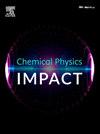金属有机骨架(MOFs)的合成、性能和应用研究综述
IF 4.3
Q2 CHEMISTRY, PHYSICAL
引用次数: 0
摘要
金属有机骨架(mof)是一种新型的晶体多孔杂化材料,可以根据其结构,孔隙率和功能进行精确调整。它们广泛的表面积、精心设计的孔结构和多种合成技术——如水热、微波、电化学和机械化学方法——使它们在能量储存、气体分离、环境修复和催化方面的应用占有突出地位。然而,诸如光催化效能不足、电子导电性欠佳和结构不稳定等问题阻碍了它们的大规模应用。诸如杂原子掺杂、缺陷工程和杂化复合材料的创造等创新技术已经取得了重大进展。例如,掺ti的mof在光催化析氢方面增加了40%,而导电的Ni-MOF复合材料则增加了五倍。本文深入探讨了MOF的合成、结构-性质关系以及使其更好地工作的新方法。它还展示了未来可能的研究路径,例如制造可以做多件事的MOF,生物启发框架和人工智能增强的MOF设计,以解决当前的问题,并在未来为MOF找到新的用途。本文章由计算机程序翻译,如有差异,请以英文原文为准。

Investigation of Metal-Organic Frameworks (MOFs): Synthesis, Properties, and Applications - An In-Depth Review
Metal-organic frameworks (MOFs) are a novel category of crystalline porous hybrid materials that may be precisely adjusted regarding their structure, porosity, and functionality. Their extensive surface area, meticulously engineered pore structures, and diverse synthesis techniques—such as hydrothermal, microwave, electrochemical, and mechanochemical methods—position them prominently for applications in energy storage, gas separation, environmental remediation, and catalysis. Nonetheless, issues like inadequate photocatalytic effectiveness, suboptimal electronic conductivity, and structural instability hinder their large-scale application. Innovative techniques such as heteroatom doping, defect engineering, and the creation of hybrid composites have resulted in significant advancements. For instance, Ti-doped MOFs show a 40% increase in photocatalytic hydrogen evolution, while Ni-MOF composites that conduct electricity show a fivefold increase. This essay looks in depth at MOF synthesis, structure-property relationships, and new ways to make things work better. It also shows possible future research paths, such as making MOFs that can do more than one thing, bioinspired frameworks, and AI-enhanced MOF designs, to get around current problems and find new uses for MOFs in the future.
求助全文
通过发布文献求助,成功后即可免费获取论文全文。
去求助
来源期刊

Chemical Physics Impact
Materials Science-Materials Science (miscellaneous)
CiteScore
2.60
自引率
0.00%
发文量
65
审稿时长
46 days
 求助内容:
求助内容: 应助结果提醒方式:
应助结果提醒方式:


